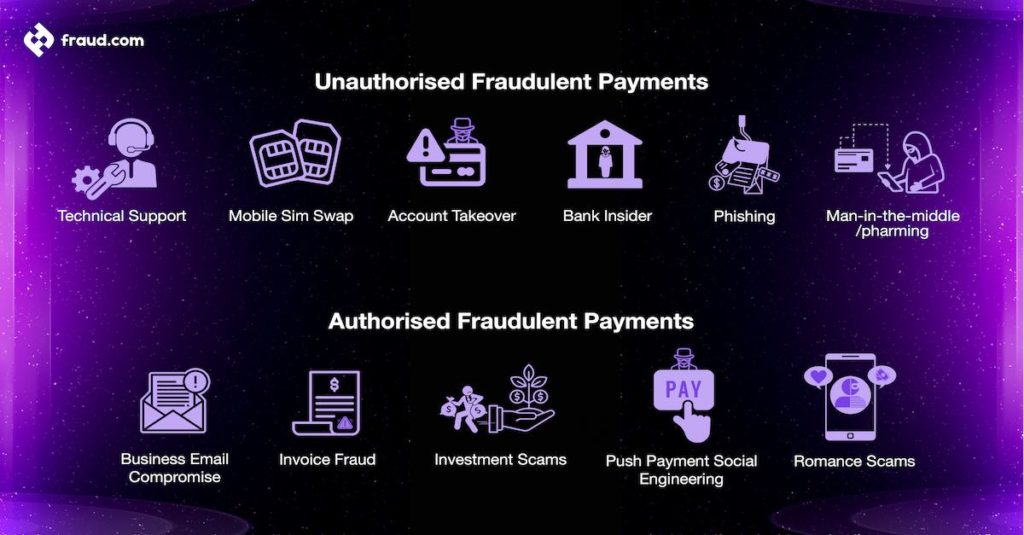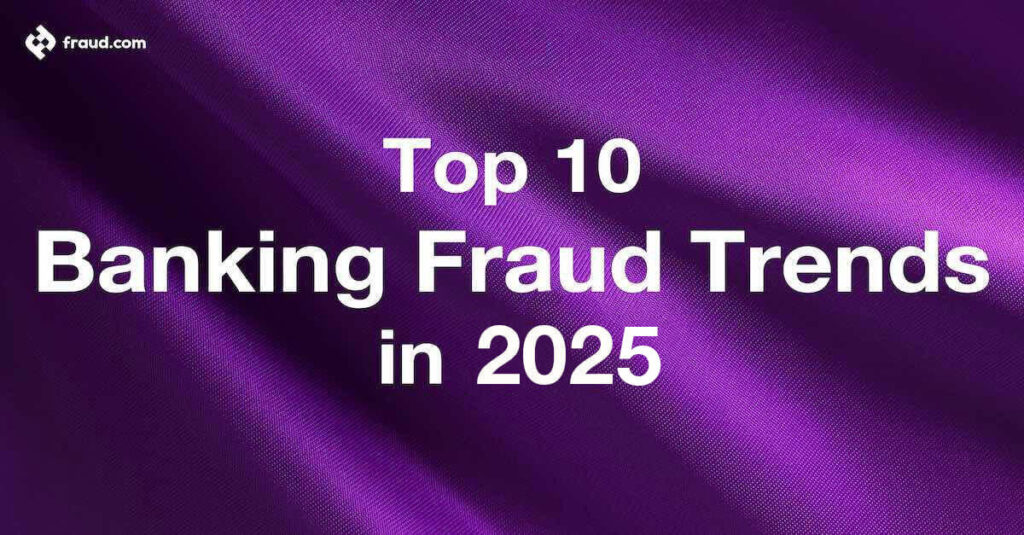Banking fraud affects all of us, from individual consumers to large corporations. As technology continues to evolve and become more integrated into our daily lives, so do the methods used by fraudsters. As such, banks and consumers must stay aware of the current fraud trends to better protect themselves.
In this article, we’ve compiled a list of the top 10 banking fraud trends that experts predict are prevalent in banking fraud in 2025
Table of Contents
ToggleReasons for the increase in Banking Fraud
There are a few reasons for the increase in banking fraud risk, including the shift toward digital banking. It provides more opportunities for fraudsters to access sensitive information and accounts such as banking details. We’ve seen a rise in phishing scams as people are frantically searching for information and assistance.
That’s not to say online banking is less secure. Banks and financial institutions are constantly adapting and improving their fraud prevention measures and fraud management. However, more scammers are comfortable committing fraud online. Some of them might not have the audacity to commit fraud in person, but they feel shielded by a computer screen.
Lastly, banks have state-of-the-art fraud detection systems. Many small and medium-sized businesses do not. It makes them more vulnerable to fraud and can potentially harm the larger banking system as a whole.
Current Status of Fraudulent Activities
There are many fraud trends which we have seen in the last few years. Fraudulent activities are the number one criminal activity around financial crime in many countries, like the U.K.
Plain and simple, fraud and scams are profitable and have low risks of being caught and punished. According to the Federal Trade Commission, in 2021 alone, there were over 2.8 million fraud reports in the USA. In the UK, Action Fraud reports that there were 875,622 fraud reports in 2021, 336,707 of which were Cheque, Plastic Card & Bank Account fraud reports. That’s a new record high and an increase from 2020’s numbers.
Banks and other financial service institutions are taking steps to combat fraud by implementing advanced technologies such as machine learning, artificial intelligence and biometrics. However, fraudsters are also constantly finding new ways to bypass these measures. In the end, it resembles a game of cat and mouse, with both parties continually trying to outsmart each other.
Below we can see the top banking fraud trends!

Fraudulent Payments (Unauthorised)
Unauthorised fraudulent payments are attacks which encompass various fraudulent activities involving an unauthorised transfer of funds from a person or company’s account. The following are types of trends which fall under the category of unauthorised fraudulent payments.
Technical support
In technical support fraud, scammers pose as representatives from legitimate tech companies. They might call or email you, claiming that your computer has a virus or issue.
The scammer will then ask for remote access to your device to “fix” the problem. During that time, they can steal personal information or financial credentials. They might also charge you a fee for this “service.”
Mobile SIM Swap
Next, mobile SIM swap fraud has risen in recent years. The fraudster can take over your mobile phone number in a SIM swap scam. They’ll pose as you and convince your wireless provider to transfer your number to a new SIM card they control.
Once they have access to your phone number, they have all your phone call, text messages, and potentially access to any two-factor authentication linked to your number. They can then use this information to commit fraud, such as accessing bank accounts or credit cards.
Account takeover
One of the potentially more damaging banking fraud on our list is account takeover. Here, the scammer gains access to your bank or credit card account by posing as you and providing enough personal information to pass security measures.
They’ll answer any security questions and change pin codes/login information. As a result, they can potentially drain your account or make unauthorised purchases. They may even take out loans in your name in the worst-case scenario.
Bank insider
A bank insider can commit fraud, usually, if you have a larger balance in your account. They have access to sensitive financial information, such as account numbers and login details. When they think you aren’t paying attention, they will skim off small amounts from your account. This scam can go unnoticed for a long time, and the amount stolen may add up over time.
They could potentially use this method for their own gain, a criminal organisation, or even sell the information on the dark web. There’s not much that can be done to prevent this type of fraud except for constant vigilance and internal audits.
Phishing
Phishing is one of the oldest and most successful forms of fraud. We all know the infamous Nigerian Prince email scams, but they have evolved and become more sophisticated over time.
Fraudsters will send emails or texts posing as a legitimate institution, such as your bank. They will request personal information or login details. These communications often contain links to fake websites that look like the real thing.
Once they have this information, they can commit identity theft or gain access to your financial accounts.
Man-in-the-middle/pharming
Another type of fraud related to phishing is man-in-the-middle or pharming attacks. Here, the scammer will insert themselves between the victim and a legitimate institution. For instance, they might intercept communication or redirect you to a different website.
They will then collect login information or personal information for their own gain. This type of fraud can be especially dangerous because it often goes unnoticed until it’s too late.
Fraudulent Payments (Authorised)
In contrast to the previous forms of fraud, authorised fraudulent payments involve the victim actually authorising a payment. However, they may have been tricked into doing so by the scammer. The following banking fraud trends are forms of authorised fraudulent payments.
Business email compromise
In a business email compromise, the scammer will pose as someone in authority within a company, such as a CEO or CFO. They may send an email requesting a transfer of funds to a particular account, that they control.
The victim, usually an employee trying to follow orders, may not realize they are being scammed until it’s too late.
Invoice fraud
In this type of fraud, the fraudster will pose as a supplier or vendor and send an invoice to a victim requesting payment. The victim may not realise that this is a fake invoice and will end up paying it.
For example, if your business usually deals with a particular manufacturer and receives invoices from them regularly, you may not think twice about paying one that seems legitimate.
Investment scams
Investment fraud involves fraudsters convincing victims to invest in “amazing” opportunities. They may promise high returns with little risk and use false information or pressure tactics to persuade the victim to hand over their money. The cryptocurrency market has proven to be a breeding ground for these types of frauds, as the lack of regulation allows for more room for fraud.
Push payment social engineering
In this type of fraud, the scammer will convince the victim to voluntarily send them money through social engineering tactics. These can range from posing as a government agency requesting payment for fake fines to impersonating a family member needing an urgent funds transfer. Unscrupulous individuals may also wait for a disaster or war and pretend to be charitable organisations requesting donations.
Romance scams
Finally, the shift of dating and socialising online has also opened the door for romance scams. The scammer will create a fake social media profile and start an online relationship with the victim. Ultimately, they will convince them to send money.
They may start by catfishing, using a fake identity and photos, and then gradually gaining the victim’s trust over time. These scams can result not only in financial losses but also in emotional trauma for the victim.
Conclusion
Fraud is constantly evolving, and it’s important to stay informed and vigilant to protect ourselves and our finances. Keep an eye out for any suspicious activity or requests for personal information such as banking details, and always confirm with trusted sources before making a financial decision.
At fraud.com, we believe in empowering individuals and organisations to take control of their finances and stay protected against fraud in real-time. Visit our website to learn more about our fraud prevention and detection solutions.









